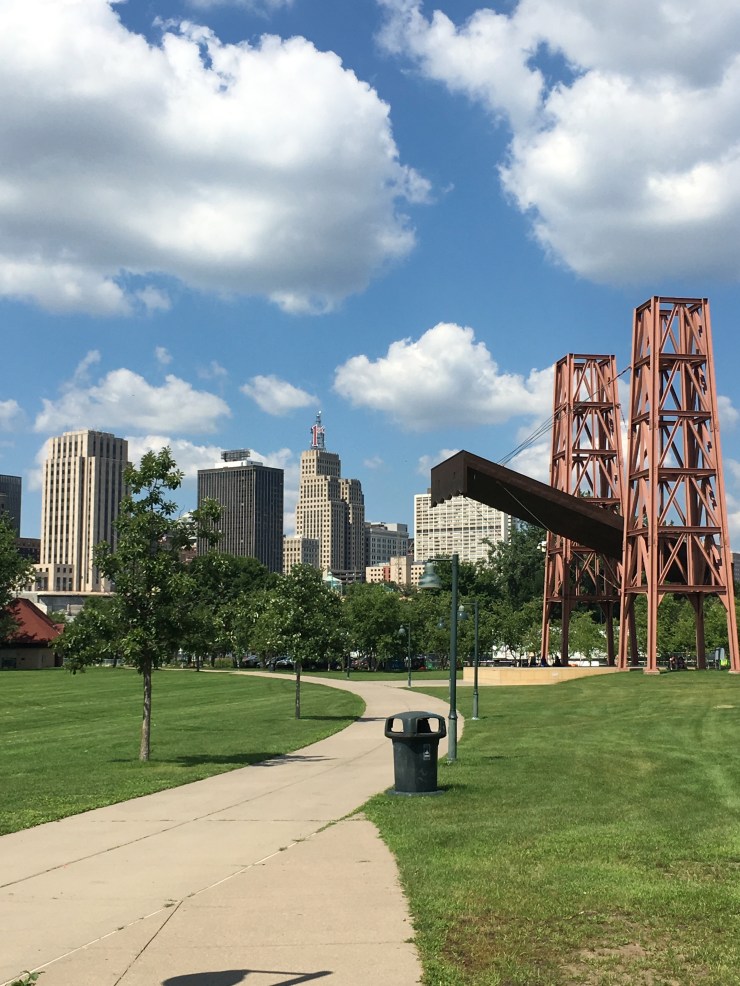
Harriet Island is one of St. Paul’s oldest parks, dating from 1900, when Justus Ohage, the city’s Commissioner of Public Health, donated the property to the city. He had raised money and mortgaged his own house to acquire the island and create a healthy recreation site for the city’s citizens. Ohage believed, “In the health of the people lies the strength of the nation,” according to John Walters in A History of Harriet Island, and Ohage put his money where his mouth was. From 1899 to 1907 when he served as public health commissioner, he was “instrumental in making St. Paul ‘the healthiest city of its size in the world,’” Walters notes.

It was Ohage who named it after Harriet Bishop, St. Paul’s first schoolteacher. At the time it was a true island, surrounded on all sides with the waters of the Mississippi River, and it remained so until the 1950s. Even before Ohage’s improvements, it naturally served as a recreation area, a spot on the river where people liked to swim. Unfortunately, before Dr. Ohage stepped in, it had become quite dangerous, with an average of 15 drownings per year occurring there. Ohage built two bath houses so people would be able to swim and bathe more safely, as well as a refreshment pavilion, gardens, and walking and riding trails. In 1901 the city added more bath houses and tennis courts, a new pavilion seating 2000 people, a bandstand, a small zoo, a children’s playground, and gymnasium. For quite a few years it was a very popular recreation spot: between 1910 and 1920, the island’s public baths served an average of 400,000 people a year, Thomas Mega notes in The Mississippi at St. Paul.

One feature of Harriet Island’s history is that it has traditionally been accessible to all, rich and poor. “Its location was accessible to those who were unable to afford streetcar fare to the more fashionable Como and Phalen parks, or to Wildwood Amusement Park on the south shore of White Bear Lake,” Mega says. Not only was Harriet Island accessible, but the public baths were free of charge to visitors who brought their own soap, towels and bathing suits. If that was too much trouble, “for two cents all needful accessories were furnished….”
Dr. Ohage must have carefully considered how to keep that accessibility, because when he deeded the island to the city, he stipulated “the institution should always be managed by the Health Department without political interference, and … it should be conducted solely as a place of wholesome recreation, free of money-making amusement features.” This stipulation held for many years and caused the city no few headaches when it attempted to make changes to the island.

Over the years, Harriet Island has been the site of many activities. In its early days it even offered a free nursery where parents could leave their children while they relaxed on the island. It was the site of four Winter Carnival Ice Palaces, in 1916, 1975, 1988 and 1992 (millions saw this last structure on television when the Super Bowl was in the Twin Cities that year). In 1912, the St. Paul Motor Boat Club, which later became the St. Paul Yacht Club, organized with its headquarters on the island. The island hosted dances and Fourth of July celebrations, and it has been the site of a Labor Day picnic off and on since the holiday was named in 1893.
The city’s web site recounts some reminiscences of the island. One visitor, Frank Marzitelli, recalled an unusual way of getting to the island for the early dances: “When I was a kid, I lived on the Upper Levee. To go to the dances on Harriet Island, my buddies and I would grab a wooden door off a railroad grain car, toss our clothes on top to keep them dry and then swim the rig over to Harriet Island where we would dry off, put on our clothes and go to the dance.”

Early on, Harriet Island boasted a complete outdoor gymnasium, free swimming lessons, slides and water games. Sylvia Brysky recalled, “In 1923 I went down a slide at the children’s playground on Harriet Island and I broke my leg. My dad had to carry me two miles back to our home on the West Side.” And some “recreational” activities at the island bordered on the macabre, as Sophie Baligrodzki noted: “I remember the real-life dreams when we went to Harriet Island to watch them drag the river for bodies and the distinct memory of the survival of a drowning dog. In those days we didn’t have TV so we relied on Harriet Island for our excitement as well as all the games and picnics.”
Yet Harriet Island has had its ups and downs in terms of usage over the years. Not that people didn’t want to use it, but pollution kept them away during much of the twentieth century. What had at one time been the center of most of the recreational activities on the river in St. Paul was considered later the city’s most centrally located cesspool (Walters). The baths were closed in 1920 because of pollution. According to Mega, “It was reported that, in the late 1920s, the river was so polluted that the stench which arose from the water on a hot summer day was almost unbearable.” Also, newer parks like Phalen and Como drew people away from Harriet.

In the 1930s plans to build a park entrance from the Wabasha Street bridge fizzled. Dr. Ohage observed the park’s decline and threatened to use the reverter clause to reclaim the property. He was particularly incensed that the city had allowed a sewer to be built across the west end of the park. “I have waited almost thirty-five years for the city of St. Paul to do something about the island,” he said, according to Walters. The city then proposed a Works Progress Administration (WPA) project to redevelop the island, but the money became available only in a piecemeal fashion, and Ohage died in 1935 at the age of 85 without seeing any progress realized.
The one bright spot in these bleak years for Harriet Island was the construction by the WPA of a pavilion in 1941. The first African American architect hired by the city, Clarence W. Wiginton, designed the pavilion which now bears his name and is listed on the National Register of Historic Places.

The late 1940s marked the end of Harriet Island’s existence as an island. The U.S. Army Corps of Engineers, authorized by Congress to maintain a nine-foot-deep channel in the Mississippi at St. Paul, usually deposited the dredged-up sand along the river shores, creating some attractive beaches. But because the river channel is so narrow between downtown and Harriet Island, according to Mega, the only place the Corps found to dump the dredgings the channel on the other side of the island, which it filled.

Other than the building of a levee in 1964 and the beginning of Captain Bill Bowell’s riverboat excursions on the Jonathan Padelford in 1970, not much change came to the island until the turn of the century. On September 9, 2000, Harriet Island celebrated a grand reopening. Today’s park is still dominated by the 1941 pavilion, but also sports a 20-foot-wide riverwalk, a new pedestrian gateway, the Ohage Great Lawn, the Target Stage–whose structure and style evoke the trusses on a river bridge, a redesigned riverfront, and more. Dr. Ohage would be pleased and proud.
February 2005, revised November 2016 and July 2018


Now I know why Harriet Island is not now an island. Love all the detail, Lisa! Thanks!
LikeLike
I like the depth and cross-referencing; very thorough and interesting!
LikeLike
I love this kind of history thank you Lisa
LikeLike
Thank you very much. It means a lot to have people enjoy these slices of history like I do.
LikeLike
Thiis is a great post
LikeLike
Thank you very much!
LikeLike